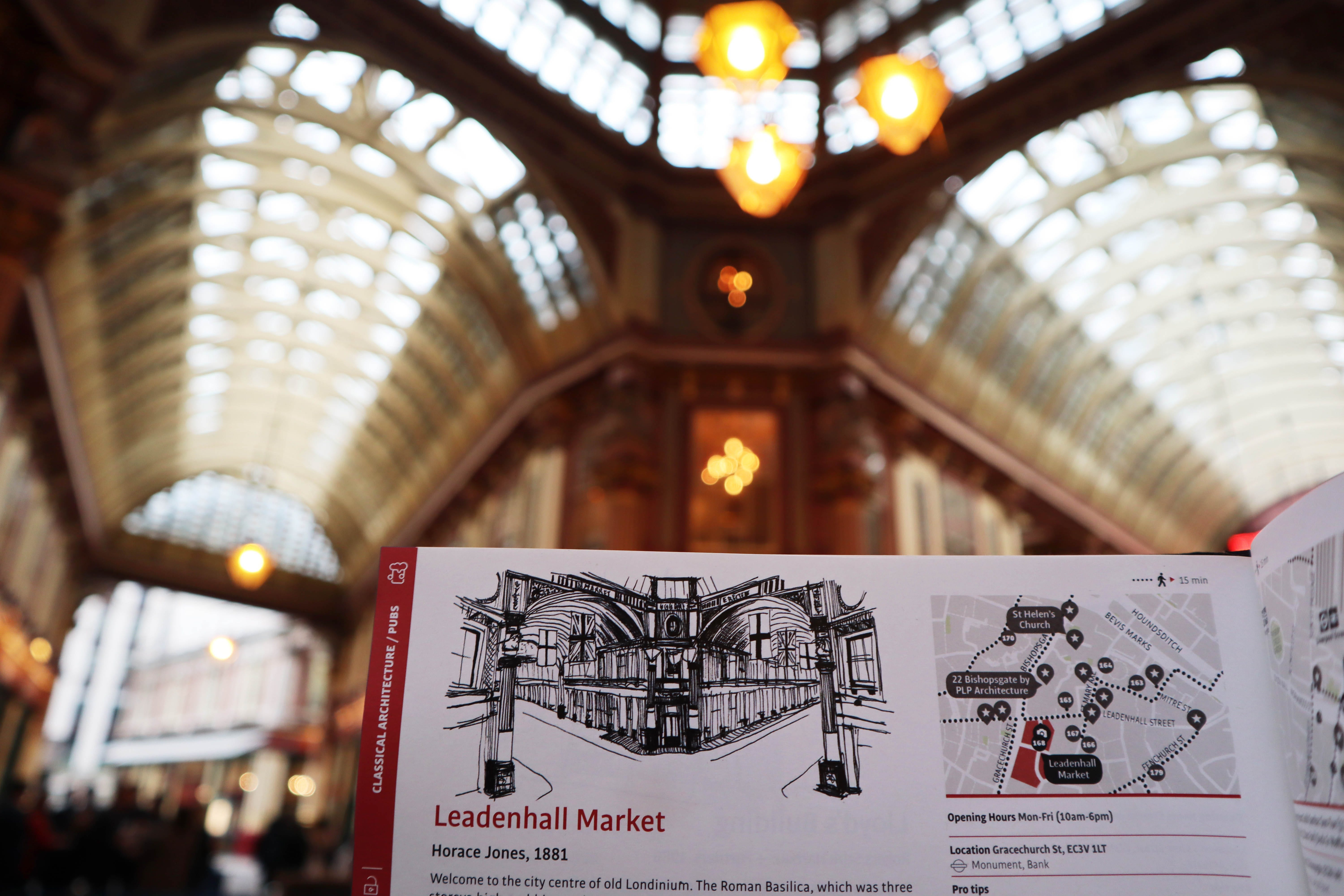How to Spend 24h in London
An optimised itinerary of everything you need to see if you love architecture and only have one day
London is one of the most stunning cities on the planet and you’ll be visiting soon. That’s exciting!
Or even better, you live in London and have visitors coming to yours to experience a little slice of the amazing city you inhabit.
Whatever your situation, 24 hours in the capital are plenty — if you plan your itinerary in advance. We know, you want to see it all and enter every museum, but that’s unrealistic (hey, it took us one year to visit every place of the guide and we were full-time explorers). This itinerary will help you get the main picture of what London is and leave you hungry for the next trip (hopefully soon?).
Details of this itinerary suggestion
Duration: 9 hours
Starting point: Leicester Square
Finishing point: Tower Hill
Means of transport: Main itinerary walking, one bus
For who: Architects (and architectural lovers), photographers and Instagram addicts // Also, a minimum level of fitness is required
What areas are included: West and East
Food: Breakfast, lunch and dinner suggestions along the way
Things you might want to book in advance: Westminster Abbey, Sky Garden, Kym’s Restaurant,
Ready to go? Let’s make the most of the following hours together and don’t forget a smile and comfortable (but pretty) shoes 👟
For more inspiration, get your Architectour Guide of London
We’ll start our itinerary by Leicester Square Station.
0. Start off with breakfast and views
An Art Deco treasure in the vicinity, this hotel offers breakfast in a beautiful environment. And AMAZING views of London. Because space is limited, if you are not a guest of the hotel, it’s always better to call in advance 02039534200.
Fun Fact: Can you spot St Martin-in-The-Fields?
Location: 1 Leicester Square, London WC2H 7NA
1. Chinatown
This delightful part of Soho is home to a hundred restaurants where you’ll find authentic flavours of East Asia. But we aren’t here for the food today. The 2 unmissable things here are: The gates on Wardour and Gerrard Streets.
Fun Fact: Did you know Chinatown used to be located near Canary Wharf until the area got destroyed during World War II?
Location: 10 Wardour St, London W1D 6QF

2. Piccadilly Circus Area
Piccadilly Circus, the Shaftesbury Memorial Fountain and Criterion Theatre have interesting (and quite funny) stories. It’s worth pausing here for a moment and reading how poor Alfred Gilbert got ruined with this statue and how the Crown and City Council never agreed on Piccadilly’s layout.
Fun Fact: Billboards have been here since 1908, but they were only located on buildings owned by the City Council.
Location: Piccadilly Circus, London W1J 9HS

3. Time to have a coffee break
If you couldn’t get a table at Hotel Indigo, this is your second chance to have breakfast, or a coffee if you need more caffeine. Thomas’s at Burberry Regent is an elegant little corner to pause for a minute and enjoy some very good coffee.
Fun Fact: This is Burberry’s first café.
Location: 5 Vigo St, Mayfair, London W1S 3HA

4. St James’s Church Piccadilly
This little and unassuming church deserves our attention as it was Wren’s biggest building until St Paul’s Cathedral was completed. It had to reinvent itself to stay alive and many activities are held here to raise the money necessary to keep it open.
Fun Fact: There’s a food market on Monday and Tuesday, 11–5pm and a n Arts and Crafts Market, Wednesday to Saturday, 10–6pm.
Location: 197 Picadilly, St. James’s, London W1J 9LL

5. Fortnum & Mason
There are two magical stores next to each other: Hatchards, the oldest bookshop in the United Kingdom founded in 1797 and Fortum & Mason, established here even before in 1707. Both are worth a detour but not much as you’ll carry whatever you buy for a loooooong way.
Fun Fact: Did you know Fortnum & Mason invented the Scotch Egg?
Location: 181 Piccadilly, St. James’s, London W1A 1ER
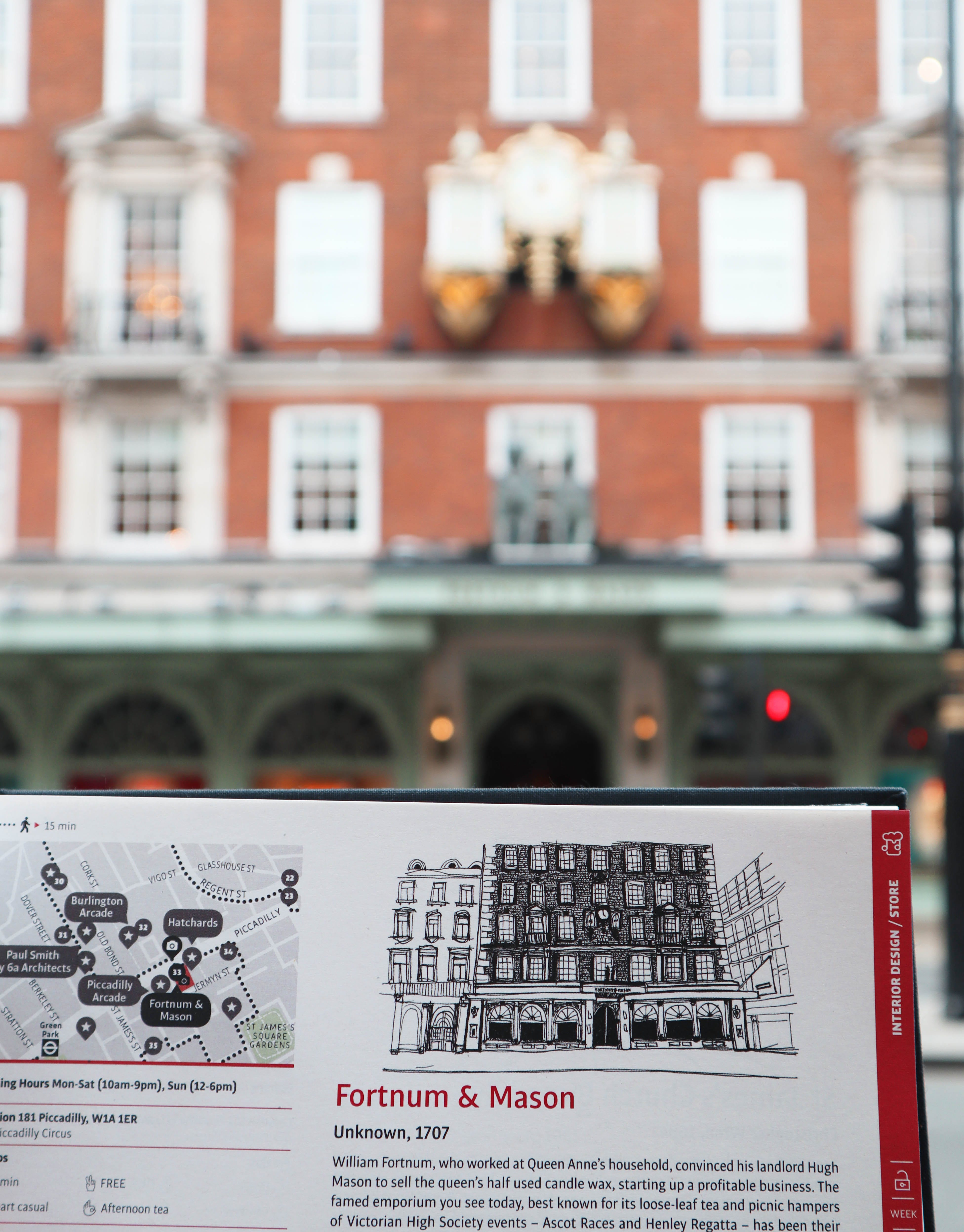
6. The Royal Academy of Arts
This charming building of 1718 used to be the house of Richard Boyle, 3rd Earl of Burlington who was also an architect (“Architect Earl” was his name). Burlington House changed the homely purpose of its premises in 1867 when it became Britain’s first art school.
Fun Fact: Check the telephone cabins at the entrance gates, they are the first ever telephone boxes in the world.
Location: Burlington House, London W1J 0BD
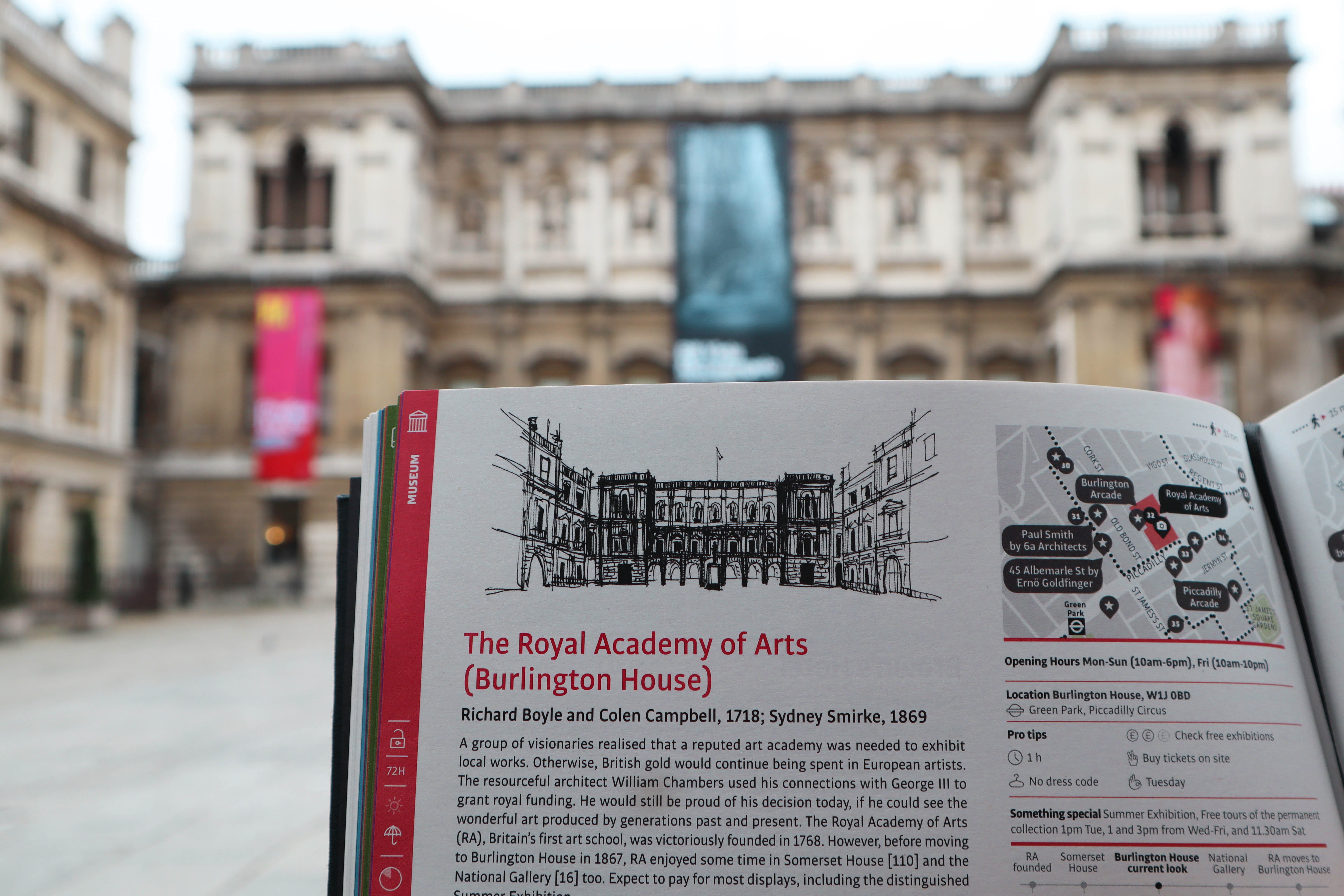
7. The Economist Building
This building is one of my favourites of the book. It’s the Renaissance of Contemporary Architecture. The proportions, beauty, layout within a plaza and harmony of the whole complex is astounding. You can actually visit the interior of the site’s smaller building as it is home to Sake no Hana.
Fun Fact: The reputation of Alison and Peter Smithson was ruined 10 years after the completion of this building.
Location: 25 St James’s St, SW1A 1HA

8. St James’s Palace
We get now into the most touristic side of London. Expect crowds and selfie sticks. All that said, visiting these classics is a must because of the architectural history and the cultural background. I’ve always found St James’s Palace hilariously odd because who’d like to have a house right in the middle of a cemetery? Henry VIII. The place is haunted like no other, that’s why I love visiting it during the bright and wonderful hours of the day.
Fun Fact: Henry VIII confiscated the land of a leper hospital to build his palace on top. His back garden was the old cemetery 😱
Location: Marlborough Rd, St. James’s, London SW1A 1BS

9. Buckingham Palace
Buckingham Palace was built for the Duke of Buckingham who by the way had seen Madrid’s Royal Palace looking slick. Long story short, the monarch and her husband currently live here.
Fun Fact: If the Royal Standard flag is raised, the Queen is in ‘da house’.
Location: Westminster, London SW1A 1AA

10. Westminster School
If you ever wondered what was this gem of a building next to Westminster Abbey, today you’ll get to learn a bit more about it. It was first built in 1179 and pupils were so naughty that Westminster Abbey and Houses of Parliament had rules to prevent children throwing stones at their buildings (they still do, ha!).
Fun Fact: Helena Boham Carter was a student here.
Location: Little Dean’s Yard, Westminster SW1P 3PF
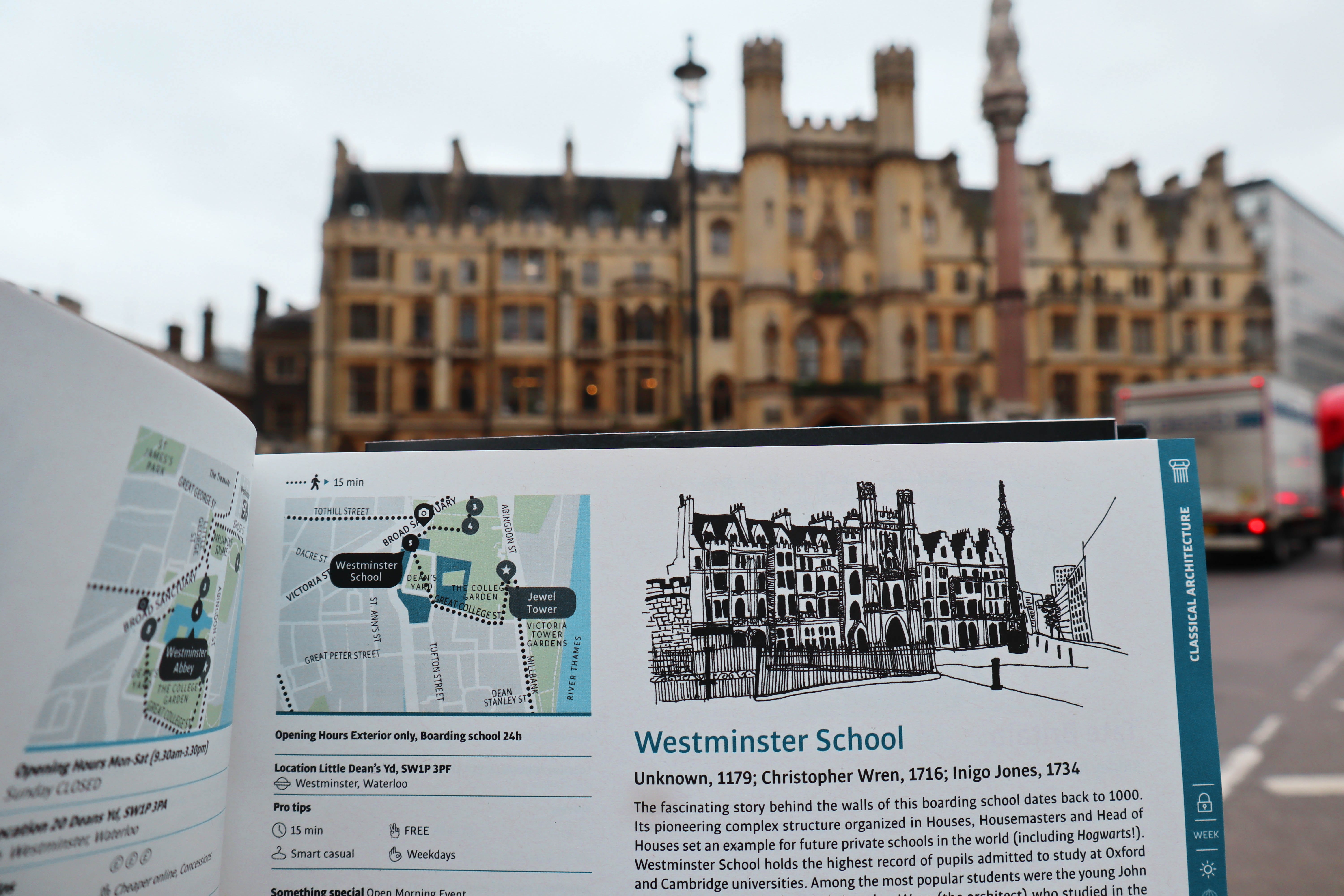
11. Westminster Abbey
Welcome to the religious origin of London. The first abbey ever recorded here was in the 960’s. Years of history are worth exploring and it’s one of the places in the list worth detouring. Admission is £22 (£20 if you book it online) and opening hours vary every day. Check them here.
Fun Fact: The last wedding here was the one of Prince William and Kate Middleton.
Location: 20 Deans Yd, Westminster, London SW1P 3PA

12. Portcullis House
This building is an engineering prowess as with the demolition of the previous buildings on site, the creation of the Westminster Station on the Jubilee line were created too. The mega structure was designed both to serve the tube and the building and the result is very neat. Make sure you stop by 10 Downing Street on your way to the next place.
Fun Fact: The chimneys were designed to match those of the building beside.
Location: 1 Parliament St, Westminster, London SW1A 2JR

13. Banqueting House
Let’s do an imagination exercise here. When this white wonder was completed in 1622, the surrounding Whitehall Palace (destroyed in a fire later in the century) was a dark construction in brick similar to Hampton Court Palace. Can you picture how this little gem was the personal delight of James I, who commissioned this structure?
Fun Fact: Paul Rubens painted the massive ceiling, it’s a beauty.
Location: Whitehall, Westminster, London SW1A 2ER

14. Horse Guards Building
This is perhaps the best place to watch the Changing of The Guard which takes place every morning at 11 am (Monday-Saturday) and 10 am on Sunday.
Fun Fact: The annual Trooping of The Colour, where the troops are presented to The Queen, takes place at Horse Guards Parade too.
Location: Horse Guards Parade, Whitehall, London SW1A 2AX

15. Trafalgar Square
Trafalgar Square, completed in 1844, was originally conceived by John Nash, who died before seeing his work finished in 1935. Charles Barry took over the job but it wasn’t until Foster + Partners remodelled the area in 2003 that it became a wonderful public space.
Fun Fact: There was a road on the Northern Part of the square until 2003.
Location: Trafalgar Square, London WC2N 5DN

16. Charing Cross
Charing Cross is a special place because it has the old hotel of 1864, the new station by Terry Farrell (1990) and Eleanor’s Cross replica. Charing Cross was the site of the final battle of Wyatt’s Rebellion, people’s uprising against Mary I, marrying Philip of Spain.
Fun Fact: There were 12 crosses erected in Eleanor’s memory.
Location: London WC2N 5DR

17. Bus 15
Take bus 15 towards Blackwall in the nearby stop F and make sure you get the top seat at the double decker bus; you’ll be taking lots of pictures: St Mary le Strand, Royal Courts of Justice, St Dunstan-in-the-West, the Daily Express Building…
Fun Fact: The heritage service still operates on weekends and bank holidays.
Location: Stop F, until Ludgate Hill Old Bailey (Stop G)

18. Paternoster Square Vents
Heatherwick Studio — who recently completed the stunning Hudson Yard’s Vessel — designed this odd structure behind St Paul’s. The purpose of this beautiful sculpture is not so glamorous: it serves as the ventilation extractor for an underground electrical substation.
Fun Fact: The sculpture is made of 63 identical isosceles triangles.
Location: 5 Ave Maria Ln, EC4M 7AQ
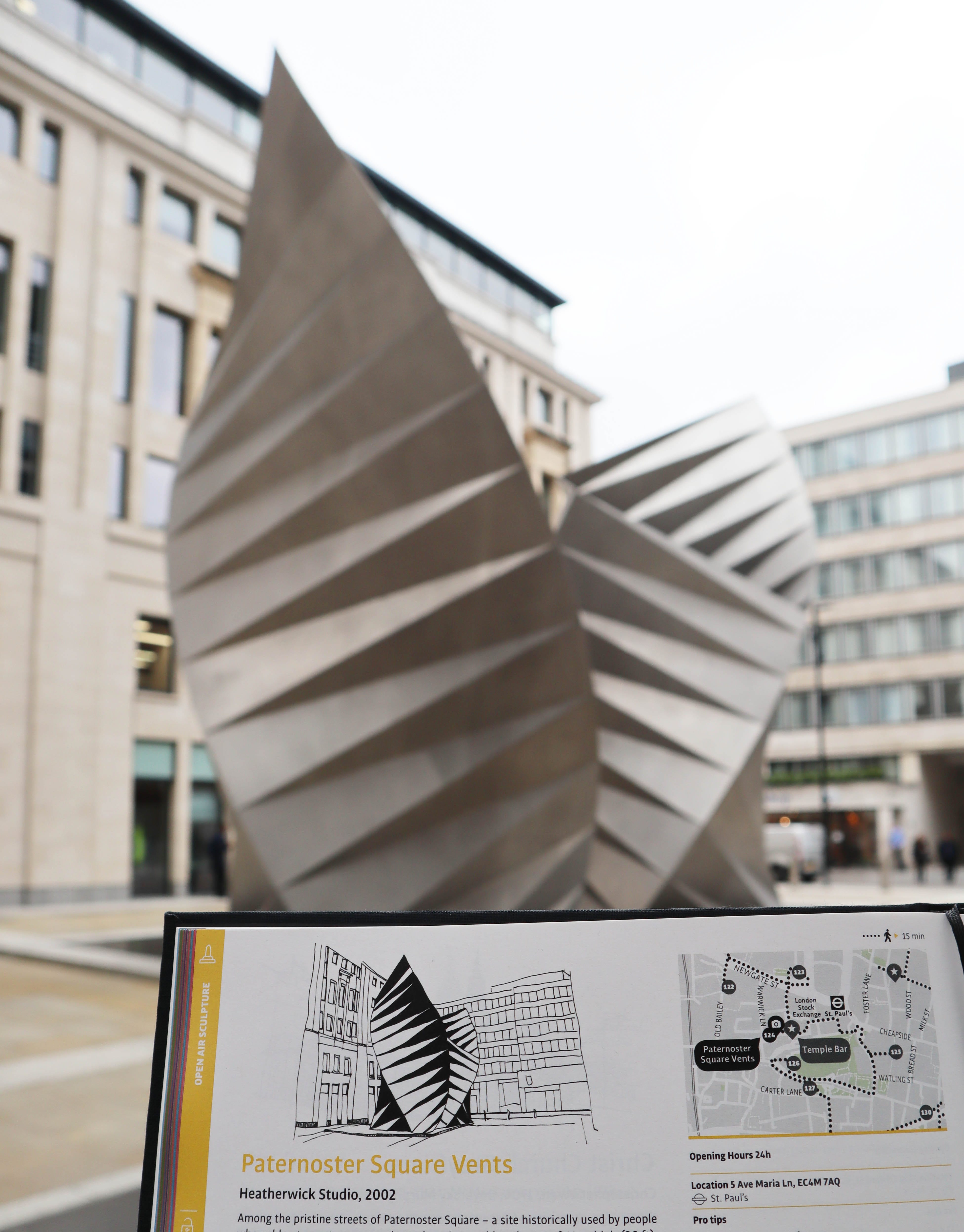
19. St Paul’s Cathedral
St Paul’s Cathedral represents the lifelong effort of master architect Christopher Wren. He devoted his entire life to it: construction started in 1668 when he was in his 30’s and finished in 1711 when he was 79. Amongst many impressive parts of its construction, the dome — the first of this kind ever built in England — is perhaps the most impressive feature.
Fun Fact: Christopher Wren is buried in the south-east corner of the crypt of St Paul’s.
Location: St. Paul’s Churchyard, London EC4M 8AD
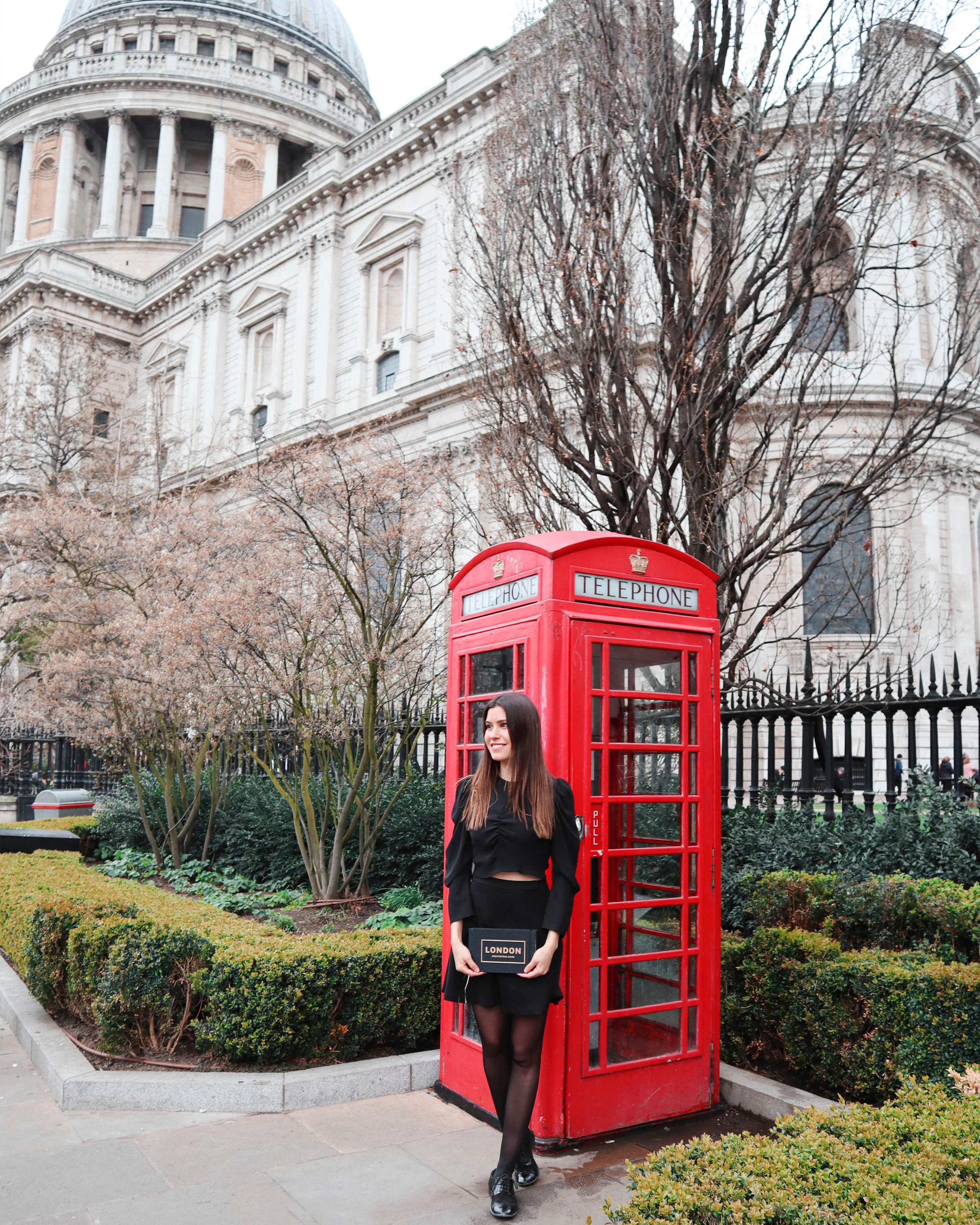
20. City of London Information Centre
Built in 2007 soon after Ken Shuttleworth left Foster + Parners to create Make Architects in 2004. The RIBA award-winning building was designed as part of the redefinition of the adjacent public space which includes the pedestrian route that ends in Millennium Bridge (not in this list so don’t get distracted).
Fun Fact: Do you think the structure has bathrooms? Check the plan.
Location: St. Paul’s Churchyard, London EC4M 8BX

21. Views from One New Change
Jean Nouvel experienced a lot of recognition following the completion of the Arab World Institute in Paris. He was appointed as architect of the Serpentine Pavilion in 2010 and soon after he finished this wonderful building which has received much criticism. Opposite to general views, I think is the best addition in centuries and respectfully enhances St Paul’s.
Fun Fact: Thomas More used to live nearby in Milk Street in 1517.
Location: 1 New Change, London EC4M 9AF

22. 30 Cannon St
The former offices of Crédit Lyonnais have become one of the most Instagrammable buildings in the City after its refurbishment in 2016. God, this building is so white and shiny!
Fun Fact: St Mildred occupied this site back in the day which is a stunning fact given that St Mary Aldermary is in front.
Location: 30 Cannon Street, EC4M 6XH

23. Drink break and planning for lunch
Feeling a bit peckish? I bet so. St Mary Aldermary is a great place to have a drink while you consider your lunch options in the area. Places we love in this area are Kym’s, Coq d’Argent and Hispania London.
Fun Fact: Check the rest sword located in the 3rd column on the right, it’s one of the two remaining wooden sword-rests in the City churches.
Location: 69 Watling St, London EC4N 4SJ

24. Bloomberg
Foster + Partners have created extraordinary buildings across London but this one is everything a building should be. One can feel the quality of its materials, presence and public spaces immediately. It was built to last.
Fun Fact: Don’t miss The London Mithraeum ruins in the basement of Bloomberg and open for free.
Location: 3 Queen Victoria St, London EC4N 4TQ

25. Lunch
You must be so hungry by now. We stopped at Kym’s for some food (you have it on the restaurant section at the end of the book). Highlights of our meal were the ribs, truffle rice and Iberico Pork Char Sui.
Fun Fact: This conversation between chef Andrew Wong regarding Kym’s is so funny.
Location: 19 Bloomberg Arcade, London EC4N 8AR

26. Cannon Street Station
Inspired by the cantilevered Forth Bridge in Scotland, this thrilling piece of architecture deals with impossible loads that form a practical yet elegant design. The brilliant structure is both the form and function of the station.
Fun Fact: You can’t miss ‘London Stone’, it has been here since the Medieval Period.
Location: Silk St, London EC2Y 8DS

27. 1 Poultry
Is this the ugliest building in London? Probably not, the City has much worse (what about The Walkie Talkie or that monster of Mincing Lane?). Let’s focus on what’s really good about this place: the rooftop views from Coq d’Argent. In summer they’re always open and it’s worth checking out.
Fun Fact: The prestigious Stirling Price was named after the architect of this building, James Stirling.
Location: 1 Poultry, London, EC2R 8EN

On your way to the next place you can quickly check Bank of England and the Royal Exchange, pages 171 and 172. If you need a coffee at this point, check Grind by Biasol Architects.
28. Lloyd’s Building
Oh hello, beautiful! This superb building is unpretentious and brutal and non architects can’t see why we are obsessed with it. Ducts, lifts and staircases are located on the outside (which is very practical) and the inside is filled with light and quality space for offices. You can visit the interior during Open House London.
Fun Fact: Even some construction cranes were left on purpose on the roof.
Location: Lloyd’s building, London EC3M 7A

29. The Gherkin
There are many wonderful buildings in this area — built and in construction — that are worth having a look on the book, we didn’t depict them all because this article would have been much longer. 30 St Mary Axe is so remarkable because it was designed and built in a time were BIM hasn’t even been created 😱.
Fun Fact: The only curvy part of this building is the piece that tops the structure.
Location: 30 St Mary Axe, London EC3A 8EP

30. Leadenhall Market
The Roman settlements in this area are still present at Leadenhall Market and if that wasn’t enough, the entrance to the Leaky Cauldron can also be found here.
Fun Fact: The ruins of the ancient Roman Basilica can be spotted at 90 Gracechurch Street’s basement.
Location: Gracechurch St, London EC3V 1LT

31. 20 Fenchurch Street
If you could get a reservation to go up to the Sky Garden, great! If not, you can always try in some of the restaurants (book in advance). If none of that worked, we have a fun fact for you not many people know: London’s smallest sculpture is located besides this building.
Fun Fact: You want another one? 20 Fenchurch Street was responsible for melting a Jaguar’s bumper.
Location: Silk St, London EC2Y 8DS

32. 120 Fenchurch Street
This is the newest rooftop in town. It has great views, it’s free and open to the general public. You’ll have amazing views of the very well-known Tower Bridge and the Gherkin but also of hidden buildings such as the Lloyd’s Register (Richard Rogers, 1999) and Plantation Place (Arup Associates, 2004).
Fun Fact: There’s a restaurant opening this summer 2019.
Location: 120 Fenchurch St London EC3M 5BA
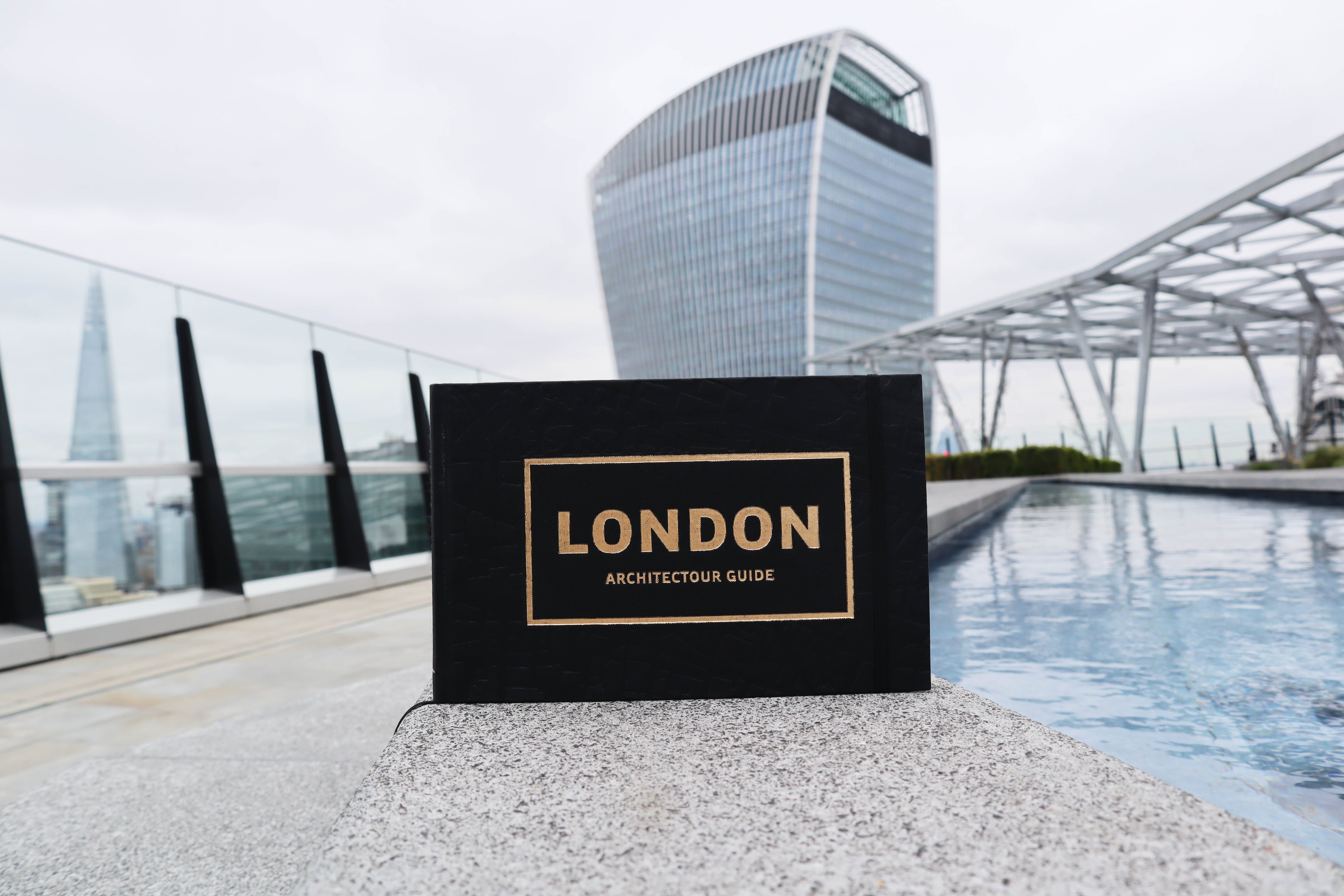
33. St Olave
This old lady was built in 1450 and still standing. Why is that so unusual? Because the City has veeeery few structures dating before the Great Fire of London of 1666. St Olave survived and continued having a Royal history.
Fun Fact: Diarist Samuel Pepys frequently mentions the church in his diaries.
Location: 8 Hart St, London EC3R 7NB

34. Tower Place
On your way here, you can have a drink at the nearby DoubleTree by Hilton Hotel London. Tower Place was built in 2002 replacing an ugly office block; in London only what is successful stays. The wrecking ball is ruthless in this city. That’s why we can tell this Foster + Partners structure is doing well every year that it’s not threatened by demolition 😂
Fun Fact: Don’t miss the old entrance to the 1868 tunnel under the Thames, it still exists!
Location: 3 Lower Thames St, EC3R 5BT

35. Dinner
A place to stop for some food and drinks is Coppa Club, which gets prettier as the sun sets. Booking is required as it is normally very busy (downsides of its premium location).
Fun Fact: The eight igloos were designed by Theresa Obermoser.
Location: 3, Three Quays Walk, Lower Thames St, London EC3R 6AH
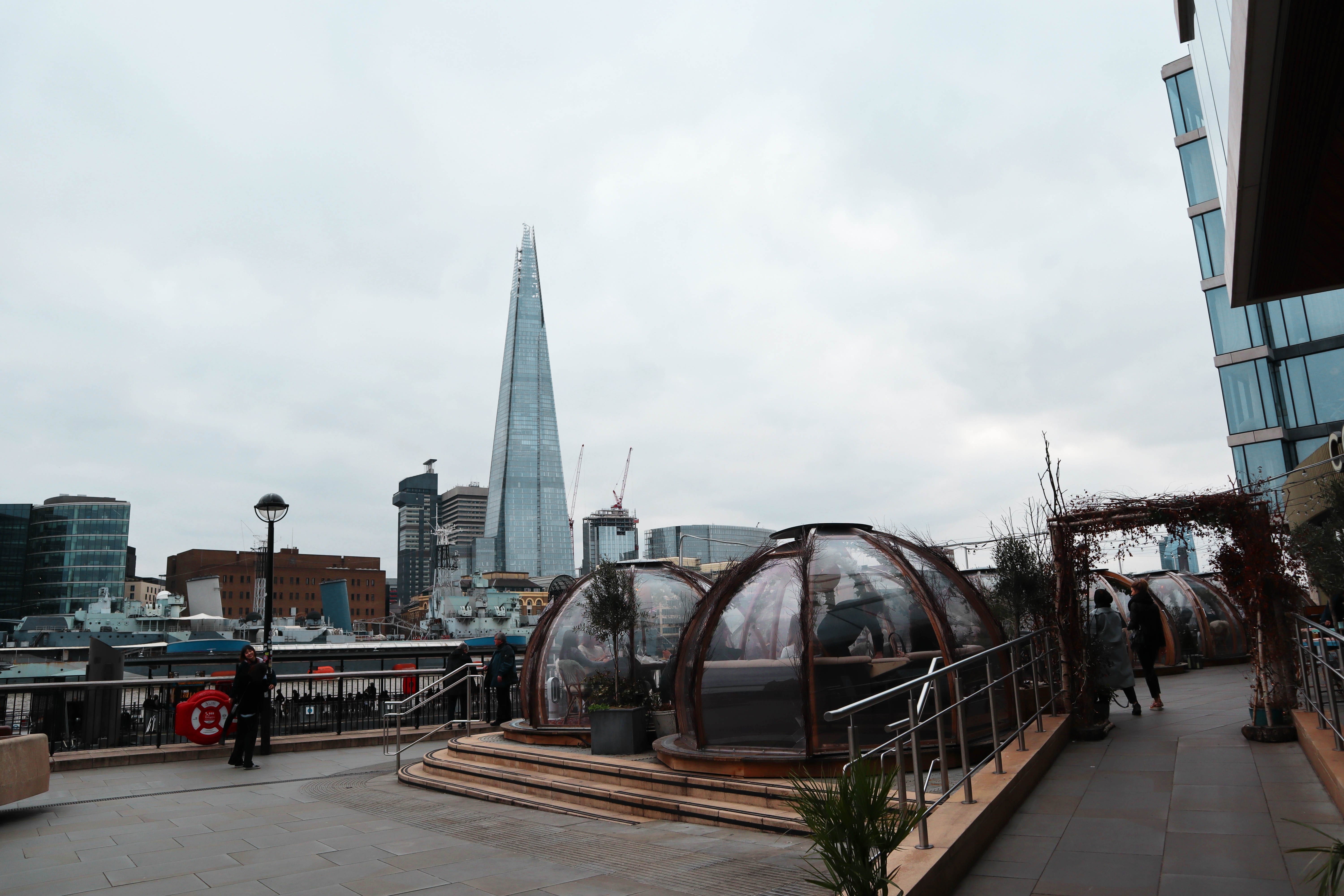
36. Tower Bridge at Sunset
Built in 1894 by Horace Jones — same architect as Leadenhall Market — as a way to cross the river at this point (remember the 1868 tunnel? it didn’t do very well). It has become an iconic landmark of London and where we’ll be finishing our walk today :)
Fun Fact: The bridge bascules only open fully for one person: the monarch.
Location: Tower Bridge Rd, London SE1 2UP

[BONUS] Drinks — Jin Bo Law
This rooftop opened last summer in 2018. The refurbished Aldgate Square is looking better than ever which makes it a perfect place for seeing today’s towers from a distance slowly lighting up.
Fun Fact: The area’s unsavoury history include that of Jack the Ripper.
Location: 14th floor, 9, Dorsett City, Aldgate High St, London EC3N 1AH
These and other amazing locations on Architectour Guide of London

For more inspiration, follow us on Instagram, Twitter and Facebook


